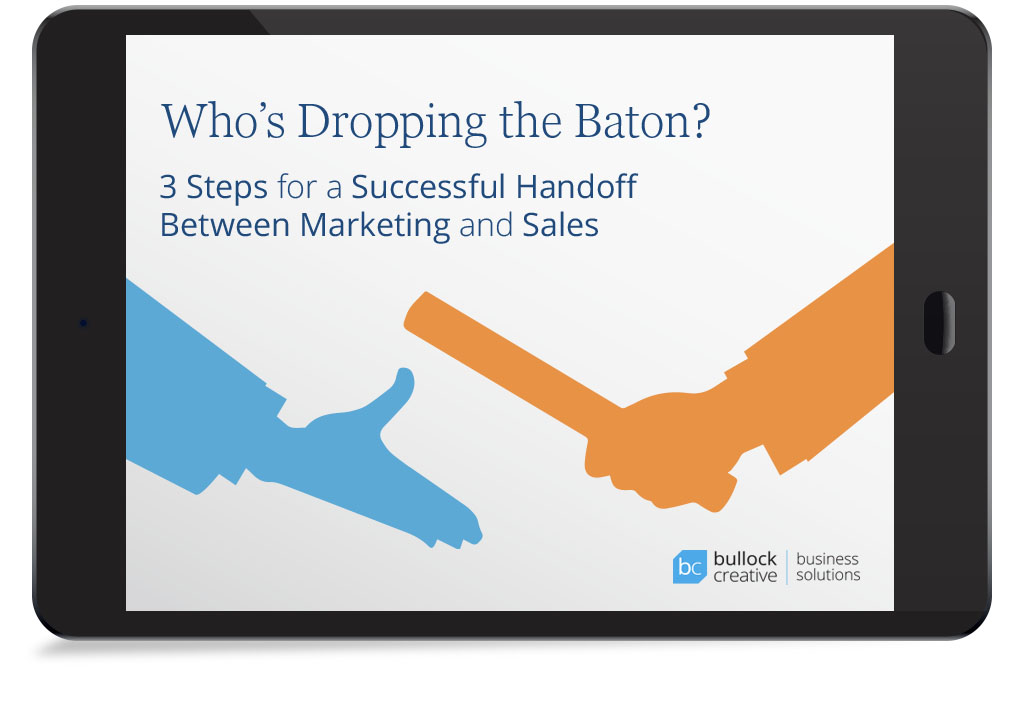3 Steps for a Successful Handoff Between Marketing and Sales
- Home
- 3 Steps for a Successful Handoff Between Marketing and Sales

3 Steps for a Successful Handoff Between Marketing and Sale
Watching a 4×100 relay race is always exciting as each athlete strategizes through each section of track, monitoring their pace, eyeing the leader, waiting just for the right moment to make a move. Then, comes the handoff, where two runners need to time it just right, one runner starting to run and the second runner slowing down and reaching out placing the baton in hand, all in stride.
Improve the Handoff from Marketing to Sales
We can help bridge the gap between your Marketing and Sales departments. Let us help get Q2 off and running!
This symbiotic relationship between two runners in a relay race is very similar to the relationship between marketing and sales. The marketing team works extremely hard to attract new customers (leads) and nurturing the leads through a series of processes to qualify them for a sales conversation (marketing qualified lead – MQL). Then the sales team takes over and works to move the leads, now a sales qualified lead (SQL), to purchase a product or service. Like the relay race, it’s possible to drop the baton at multiple points before, during, and after “handoff.”
3 Drop Points to Watch For
Although the handoff from MQL to SQL seems straight forward, the truth is that most companies struggle to get this right. There are a couple of critical areas where leads can get lost and never convert to a customer. Below we’ve outlined the problem areas and listed solutions for overcoming the gaps.
According to a ZoomInfo study, 44% of salespeople give up after one follow-up, and 92% of salespeople give up after no sales on the 4th call. But, 60% of customers say no four times before saying yes!
Breaking Down Silos
Marketing and sales get siloed because they are both working to drive lead development and sales, but they go about it in two different ways. Inevitably, when sales drop, the two departments blame each other for not driving growth. Marketing will point out all of the web traffic and leads they have generated. Sales respond by pointing at decreasing close rates and increased number of touchpoints to close a deal.
Solution: The marketing and sales departments need to work in unison. From marketing campaign development to sales script, both departments need to work together in building a cohesive “branded” message. By working together, they will begin to move the Flywheel, and once it begins to move, it will be unstoppable.
“The new reality is that sales and marketing are continuously and increasingly integrated. Marketing needs to know more about sales, sales needs to know more about marketing, and we all need to know more about our customers.” – Jill Rowley
Build a Process for Success
Marketing and sales usually have entrenched processes (sometimes outdated) that guide their activities. Typically, these two processes are at odds with each other. When a new customer rises and is ready for a call from sales, the two processes compete, and the new “warm” lead gets cold and eventually loses interest.
Solution: This may sound simple, but there needs to be “one” process, not two. Start by getting marketing and sales to build out the complete buyer journey. Utilize a CRM system like Outreach IO to place warm leads (MQLs) to be nurtured further by the sales team. If marketing and sales work together to build out all of the campaigns, communication and offers for every stage of the buyer journey, this will provide a comprehensive buyer experience and prevent the baton from being dropped.
“Sales and marketing alignment is about one shared goal: revenue that is delivered or over-delivered every quarter. There will always be tension, but that tension can be positive if there is a culture of clear expectations and communication.” – Craig Rosenberg
Follow Up & Reporting
It’s my experience that both marketing and sales have different types of reporting and follow-up with cold leads. Reporting for marketing is typically centered around the number of leads generated each week, and the amount of money spent, referred to as cost per lead (CPL). Sales will look at the number of phone calls made and revenue generated. Marketing follow-up consists of relentless email marketing without regard to the discount offer or even value to the contact. Sales will call and call and call then mark the lead unresponsive when they don’t pick up.
Solution: Not that marketing will stop tracking leads and budget spend each week, but if the two departments were unified, they should both report on revenue by lead and time to convert. Again, by working together on every aspect of the buyer’s journey, the two departments can share in the success. A comprehensive buyer journey which is owned by marketing and sales, then follow up will not be a problem. It’s important to remember that without significant revenue, both departments will not survive.
Working in an organization is no different than team sports; if we all work together, the organization wins.
Need help bridging the gap
between Marketing and Sales?
We're here to help.
Fill out the short form below, and be sure to write in the memo “BATON”.










